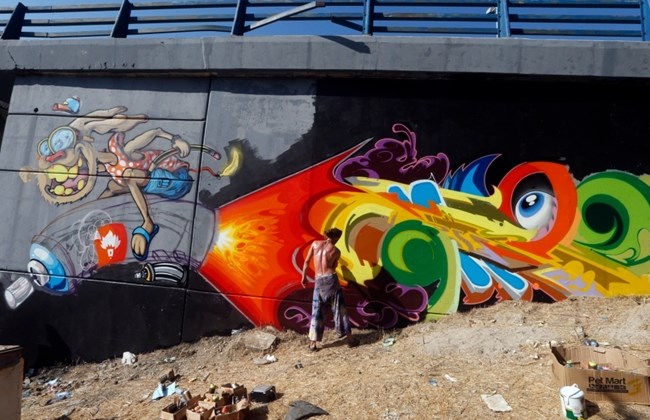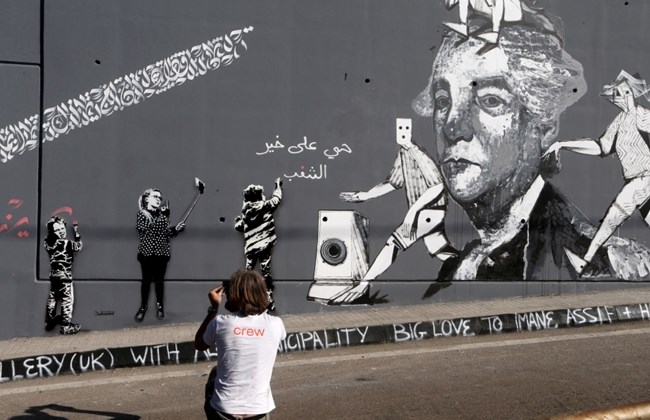ALEY, Lebanon: An explosion of images adorns the drab concrete – from eye-popping Arabic calligraphy to cartoon characters, from Banksy-like stencils to Cubist paintings. In advance of Aley’s ambitious arts and cultural festival this weekend, Ahla Fawda (literally Best Chaos), the festival NGO has partnered with the municipality of Aley and the Tourism and Culture ministries to commission graffiti from a selection of Lebanese and U.K. street artists.
After the success of Ahla Fawda’s event in Hamra last year (evidenced by the monolithic Sabah painting adorning the eastern face of a Hamra Street structure), founder Eman Assaf decided to extend the festival’s geographic reach, in more ways than one.
She rang up London’s RISEgallery – known for transforming the South London borough of Croydon from a cultural desert to a hub of street art – and asked director Kevin Zuchowski-Morrison to bring his vibrant art scene to Lebanon, not just Beirut.
So it is that Ahla Fawda is debuting in Aley. Incorporating art installations, concerts, a farmers’ market, carnival games, a book fair and yoga classes, the event seeks to return the quiet city to its former glory as a tourist destination.
“You used to not be able to walk in Aley during the summer, it was so crowded with tourists,” Assaf tells The Daily Star, surveying the town’s empty square and shaking her head. “I have no idea what happened.”
Perched high above the coast, Aley has long provided Beirutis with refuge from the summer heat.
More recently it’s lent relief to Gulf tourists too, but regional politics has seen tourism from that region slump in recent years, leaving towns like Aley hoping locals and vacationing expats will fill the gap.
To boost the town’s appeal, the governor installed over 200 sculptures by Lebanese and international artists in Aley’s main square, signaling the city’s desire to serve as a center for art and culture in the future.
“This place has incredible art, old buildings, vast views. It could be just as important as Jounieh or Baalbeck, and only 30 minutes from Beirut,” Assaf says. “We’re here to highlight the work already done, and bring it the attention it deserves.”
International artists braved the humidity to decorate Aley’s derelict freeway bridges throughout the week. On the road, drivers honked, stopping their cars to gawk, shake hands with the artists, and express their gratitude. “I’ve never seen anything like this,” one woman cries from her car window.
“What we found in Croydon is that street art is the most relatable and accessible art,” Zuchowski-Morrison says. “Like architecture, it’s just there. You’re forced to engage with it. It’s a doorway from which other art forms can emerge, and add nuance to the human experience.”
While famous artists have come to Lebanon, adorned some walls, and dashed back to Europe, “we’ve never seen real partnerships between Lebanese and international street artists before,” Assaf says.
“Through the festival’s street art, we’re working to grow local talent while also creating long-term cross-cultural collaboration.”
After the festival, several participating Lebanese artists will travel to the U.K. for residencies.
The street artists’ styles differ as wildly as their backgrounds.
“My style is freestyle funky fresh psychedelic surf,” proclaims Morgan Davy from the South London Minesweeper Collective, gesturing toward his colorful abstract mural. “I usually paint underground London squat raves. I grew up surrounded by this stuff. There’s a huge street art scene where I’m from.”
Nearby, Lebanese graffiti artist Exist spray-paints a wall with elaborate Arabic letters. “When I was little, hip-hop was always on the radio talking about this thing called graffiti,” he recalls. “It didn’t exist where I’m from in the mountains and, though warring gangs often tagged their territory with it, graffiti in Lebanon was never the art form it was in the U.K.”
Exist’s collective, RBK (Rioting Bunch of Klowns), adopt street-art styles from the skateboard cultures of France and Greece, and add a distinctive Lebanese touch. “I started out doing Latin graffiti because that’s all I knew and saw but then I realized I could bring my own language to this art, and began improvising with Arabic.”
Working side by side, the artists chatted and stole glances at each other’s art, picking up different themes and techniques by osmosis. “I can’t help walking around to see what everyone else is doing,” Exist says. “Each time I view my own piece in a new way.”
Dan Cimmermann, a U.K. artist who specializes in portraits of historical British figures, has branched out into Lebanese historical figures. “Since I’m here in this new culture,” he says, “I might as well stretch myself a bit.”
Lebanese graffiti artists are also stretching themselves culturally – just by leaving Beirut. “Cities like Aley are close-knit, conservative. You can’t just grab your paint and take to the streets,” says Spaz, a Chouf street artist who works with Exist. “We want to explore our country but it’s hard to find places outside private and government control. We’ve been waiting for a program like this that allows us to really enter a community.”
The benefits of engaging with small cities like Aley or Croydon run deep. “In Croydon, we approached street art as a marketing strategy: How to make an uncool place cool?” says London artist Dotmasters, known for his role in Banksy’s film “Exit Through the Giftshop.” “People are being pushed out of London because they can’t afford it and they’re moving to places like Croydon. There’s a hunger for these areas to be bright and alive – not gentrified, but enjoyable and desirable for people.”
Given Beirut’s own fondness for skyrocketing rents, places like Aley have the potential to become destinations for more than short-term tourists. “While the government sleeps, it’s up to us to wake up and do something new for these cities,” Assaf says. “All it takes is a bit of paint for people to realize the potential of an already beautiful place.”
The Ahla Fawda Festival gets started at Symposium Aley, Saturday Aug. 5 and runs through Aug. 6.








